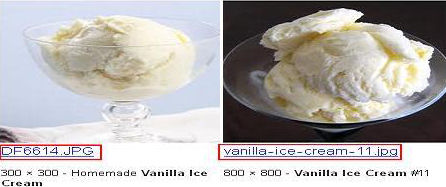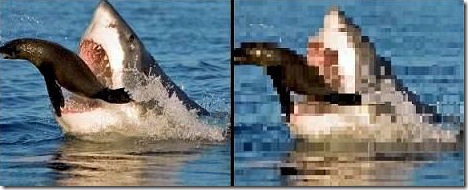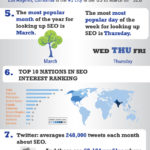Plenty of bloggers and webmasters are struggling to have their pictures indexed by search engines. To top it off, they have to contend for the first page or top spot in SERPs with millions of other website owners to grab the attention of their target audience.
Despite these, they apply every strategy imaginable just to make their uploaded photos appear on Google Image Search.
For some individuals who have no idea about the great impact of being no.1 in query results, they are probably wondering why other people spend so much time developing and optimizing their sites.
Now if you already know the huge importance of getting a high ranking and you want to reap the benefits, you can try these strategies, which I have personally tried.
Rename image files
Technically, cameras assign seemingly random names to your snapshots like DC3098506986.jpeg.
Hence, it is important to change the filename before uploading your photos. To do this, right click on the file, select “Rename”, and type in the new name (which must be descriptive of the shot).
Why do Google recommend this?
The filename is part of the information that appears in search results. Your picture will look better if it has an illustrative name. Check out the difference between the images below.
As a tip, I use simple words and insert localized keywords to target those queries related to my photo.
Use Alt tags
Search spiders use Alternative Texts as a small factor when indexing pictures since they cannot see the content. Therefore, you must not neglect this strategy because it might just be the key to have your photos included in the top page of Google Images.
When creating an alt attribute, you need to highlight the photo’s entire content to benefit those people who use screen readers to understand (or see) the information you are presenting.
Another tip, do not just create alt tags for SEO, make them for your viewers.
Upload high-quality shots
Sure, your photos may come out in query results, but do they appeal to the users and entice them to visit your website?
Creative descriptions and alt tags are not enough factors to help you gain traffic; you also need to use excellent images. Furthermore, these have to be interesting and relevant to your niche or topic.
See the example below:
There is a clear distinction between a high and low quality image. So make sure that before you post your picture, edit it, tweak it, or enhance it first using Photoshop or any other photo-editing software.
Include text descriptions
Some individuals depend on a software application that helps them recognize, interpret, and understand the information or images displayed on their computer. This is why you have to include illustrative captions, as you would on a Tumblr post, because the program goes through these words.
Other than this, Google uses the descriptions as snippets in search results pages, giving the viewers a brief intro about your content.
Given that, you need to use ideal phrases to describe the photos; otherwise, the users may leave your page right away after seeing that the image does not relate to the article at all. This can lead to a high bounce rate, which can affect your page rank.
Format photos for specific queries
Many people look for wallpapers, desktop backgrounds, and mobile phone screen savers on Google Image. Appealing to this crowd will also usher in traffic for your website.
So how do you cater to this group of Web users?
First, format your photos according to size standards. For example, 1600×1600 is ideal for wallpaper pictures, while 50×50 is great for profile pictures and thumbnails. You can use Photoshop to crop, resize, and change the resolution.
Second, vary the extension format of your images. You can use JPG, which is ideal. Alternatively, you can opt for GIF, which is a bitmap photo format. Or, you can choose PNG, which you can easily compress.
Conclusion
Before we end, you have to know that keeping track of your indexed photos is part of your optimization strategies since it helps determine the effectiveness of your methods.
So, these are some of the ideas, which I have learned through trial and error. If you have your own tips, which you want to share, the other readers and I would be happy to hear about them.












Aditi
Hi Emma,
I must say that your post is really very informative. Adding appropriate images to the post definitely increases the traffic rate. Even, I use this process too. All the tips that you have provided in your post are just great and specially the one of using high quality pictures in your post. This is actually absolutely true. Even, I think that images added should be related to the post. Thanks for the share!!
Emma
I’m glad you found my post informative, thank you. And thanks too for sharing your thoughts on the topic. 😉
Jane
Google is pretty serious about low quality images. My authorship headshot was not even appearing in the SERPs until I changed to a good quality image (I got the notification in my Google plus profile image). So yes, if it is so with profile images, we can understand how google will treat poor quality images on image search results!
Emma
You are right, Jane. Based on the results for Google Images, we can see that all the images have high quality. If we want our pictures to rank in the first page, we must not settle for low quality. Thanks for commenting! 🙂
Sanjib Saha
Hi Emma,
This is a very useful post. Google images are a great way to increase traffic to your blogs and sites. Just yesterday, I came across a feature called spinning images. It looked so interesting that I felt it can help a lot in drawing traffic. Though this is not a part of google, it will be great if it is included in its features.
Regards,
Sanjib Saha
Emma
Hello Sanjib. Thanks for your appreciation. I have noticed these spinning images myself and I think that their importance as additional feature on our content depends on how the readers react to them. So, let’s see if many readers suggest these in our next posts. 😉
Thanks for sharing this info with us.
Sanjeev | Makewebworld
Google Image can be a great way to generate the traffic for a site, these days people do search for images. Not only that Google Panoramio is also a good place for images, good quality images will be included in Google Maps and Earth, and can bring traffic…
Emma
Google Images indeed helps our ranking in SERPs. Thanks for adding your insight on the topic. 😉
Elena Anne
Images without doubt make readers engage with blogs to a greater degree. I also like informative posts that have graphs and other types of graphics. Makes a change from straight text and is attractive to look at.
Emma
Indeed, Elena, images and other types of content make our posts more appealing to the readers. Thanks for sharing your own thoughts. 😉
Excellent post this is very similar to what I have found with images.
Have you been able to determine if the traffic that results from the images searched is targeted or not?
Emma
Thanks, I’m glad you find this post excellent. 😉
As for your question, the traffic coming from image search is mostly targeted since the queries are generally specific. So if I have a photo of a red Porsche and I optimise it well, it has a higher likelihood of ranking in the top row of Google Images whenever the users enter the keyword “red Porsche”. When some of them access my site through the image, I get targeted or quality traffic.
Taswir Haider
Thanks for your useful sharing.
How shall I write Alt Tag. Shall I need to match it with the file name (say, vanilla ice cream) or post title (say, The best vanilla ice cream in the market)?
Please advise.
Emma
Your alt tag must be descriptive of the image and, of course, it must contain the primary keyword. These two elements are important for the sake of optimisation and for the best interest of some users.
If you say “the best vanilla ice cream in the market”, it sounds like a sales pitch. Think of it as describing the image to your audience. Maybe you can say, “Plain vanilla ice cream on a dish”. The main idea is to tell the users (especially those with visual impairment) exactly what the image presents.
I hope you understand my explanation. Anyway, thanks for appreciating my post. 😉
Cordell
I’ve done a fair bit of research on how to better rank. Surprisingly through all the articles/blogs I’ve read this is the first one that goes over pictures! I understand why I’ve been advised to rename my pictures to what they actually are. I’ve just been a tad lazy in the past and changing my view in my folders to “thumbnail” and search that way.
Thanks!
Emma
Renaming our images help in boosting our chances of ranking in Google Image search. So, we must never forget it. Thanks for sharing your realisation! 🙂
Hi Emma,
Your post is awesome. Google images is definitely a great idea to draw more traffic towards your blog. Images add to our ideas and give a detailed view of our posts and articles. Relevant images combined with a useful article is what the users look forward to. Google images shall come in handy to achieve the objectives in all aspects.
Regards,
Amit
Emma
Hello Amit,
Thanks, I’m glad you think my article is awesome. And, yes, Google Images indeed increases the amount of traffic coming to our blog. Thank you for adding your own ideas on this topic, Amit. 🙂
Emmy Collins
I get lot of traffic from google images and images on other search engines. when I check my site stats I see the traffic sourse and I found google images on top. It is because I always rename my photos according to the post.
Emma
Yes, it really pays to rename our pictures and practise other image optimisation strategies. Thanks for sharing your insights, Emmy. 🙂
Declan
There’s no doubt that images are important for your website, but I have to question the purpose of using images for traffic purposes. I mean, if I’m searching for an image, I’m looking for an image not content or a website. I have gotten a lot of visitors from people searching fort images on Google, but have found the traffic to be useless.
Emma
You are not alone in thinking so, because several people also question the importance of optimising images.
To start, they are not just for making your content more appealing. You can actually obtain traffic from photos, particularly when the users access your site through these. For example, I am looking for images of black dresses and I happen to find a great design. I am so interested in the dress that I click on the site to find information.
You say that the traffic you get from Google Images is useless, maybe they only stumbled upon your pictures while browsing and decided to check out your site. 😉
Eyern
When I have searched for images on the web I don’t think I have ever gone and looked at the website the images were on. Usually after I have gotten the image I go and look for another.
So I wonder how valuable the traffic actually is (I am sure the bounce rate is high).
Emma
Given that image searches are mostly specific, you can obtain quality traffic from your images, especially if you optimise them well. 😉
Thanks for the info about this, Emma. Since my blog deals with topics like travel, food and dining, I’ve been a bit anal about the quality of the pictures I would upload along with my posts. But I have to admit, I don’t really bother that much about the description part. Reading through your post just gives me one more reason to be more meticulous when it comes to the kind of images and photos I include in my photos, and be more patient when it comes to adding text and descriptions.
Emma
You’re welcome, Adeline, and good luck on further optimising your images. Thanks for sharing your realisation with us. 🙂
Hello Emma,
You have posted a great article. Just read about google images on net. This feature makes it easy to search images of your choice in a jiffy. You can use an image you have or enter the details in the search area and you can end up finding related images all over. As said above, pictorial description is a great way to explain your subject.
Regards,
Raj Kumar
Emma
Hi Rajkumar, thank you for the appreciation. And thanks also for sharing with us your discovery of Google’s Image feature, wherein the users can click a camera icon to arrive at two options—upload an image or type in an image URL. 🙂
Suzanne
Wow. The things you can learn by reading blog posts and comments. Didn’t know about the renaming images or using quality images. Thank you! Suzanne
Emma
Thanks Suzanne! I’m glad you learned something from my post. 🙂
Valery
Excellent post, Emma!
I like when blog has a lot of quality images and photos, which make blog more attractive to visitors. I wonder, should I place only unique images on my blog to promote it through google images?
Best regards,
Valery
Emma
Hello Valery, thanks for appreciating my post. As for your question, it is much preferable to place your own images to help your content stand out among other similar photos. If you wish to use the images of other websites, you need to give credit to avoid complaints from the owners. 😉
Aditya
An image is the portrait which expresses everything about it.To be at top one has to perform good and that’s why Google has always considered the top quality images.In the end its quality that matters not quantity.
Emma
You are right, Aditya. Thanks for sharing your understanding on our topic. 🙂
It’s good to know about these things. I am not very technical and usually don’t pay attention to stuff like these. For instance I would just directly upload a picture from a camera, maybe edit it a bit, without changing the name. Or if I do change it, I won’t really pay too much attention to what I change it to. Now I will. Also, I will make sure the image are of high quality.
Tania
Some good advice on optimizing images for your website or blog by themselves they do not make much impact but if you are optimizing your site correctly all these small changes can help with your SEO and ultimately your traffic.
Tania
Nitesh Ahir
Sir,i appreciate all your doing,if we can get more of u in this world,it will be a better place to stay.
Mahendra Chhimwal
Hi Emma…
Ya you are absolutely right.It is a fact that human attract more towards images than a text.Thats why Images are important for a blogger in his/her blog post.Images get someone traffic.These also make the post interesting and readable.Thanks for tips for selection of appropriate formate of image for blog post.
Sudipto
hey Emma,
Nice post and Yes, Images really helps to increase traffic and I really like all the tips mentioned by you. I really like the first point. Thanks for sharing this post.